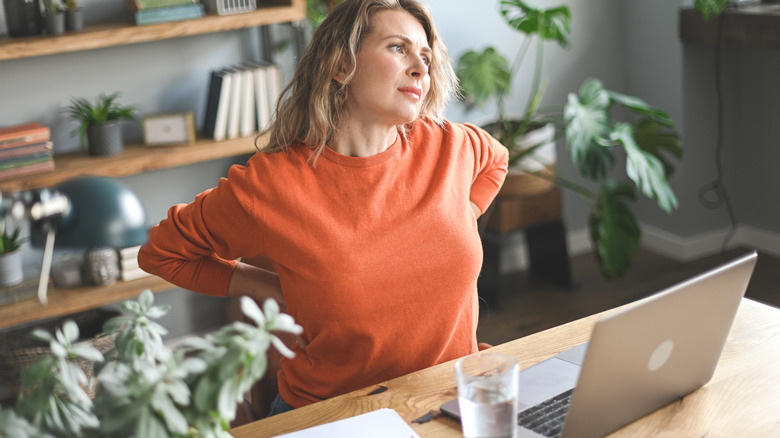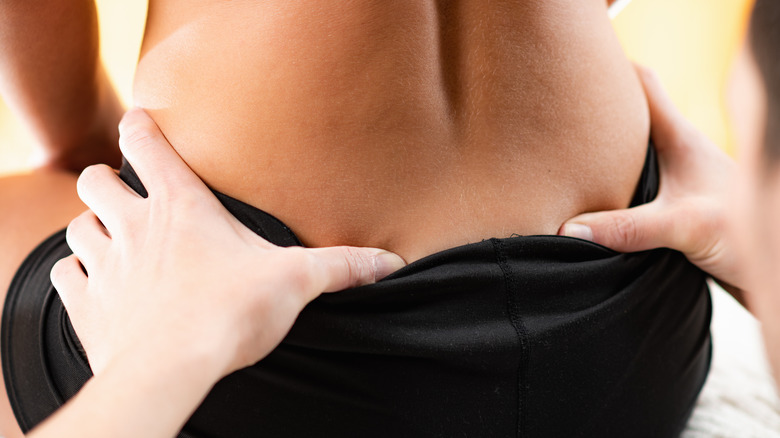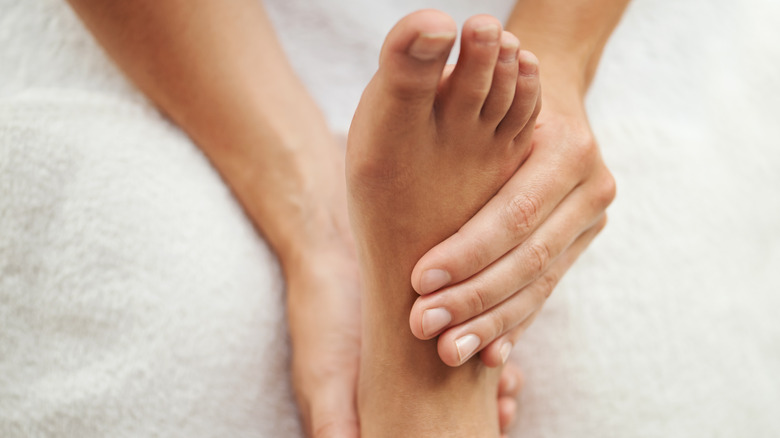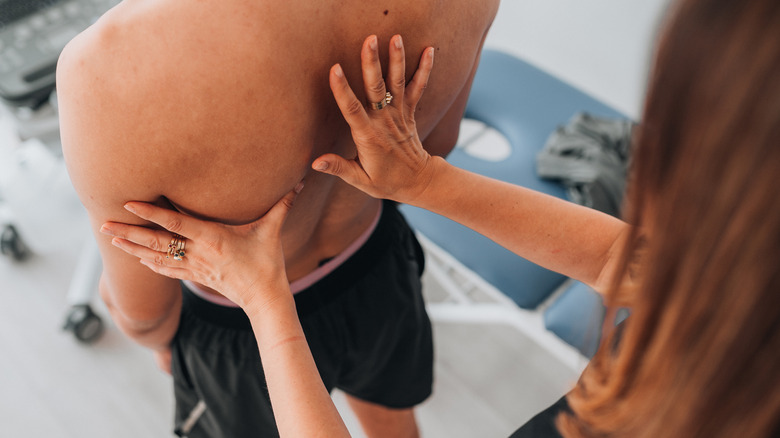Turns Out We Have Several Buttons To Relieve Back Pain. Here's How To Find Them
When you can't bend down to put your shoes on or get out of bed every morning without feeling soreness in your back, you can start to feel frustrated. There's nothing like back pain to remind you how important the tissues, ligaments, muscles, and spine that make up your back are for everyday movements. Everything from brushing your teeth, sitting for work, or walking to the grocery store can become cumbersome with back pain.
If you're tired of cold and warm water packs, painkillers, and sitting in weird positions to find some relief, acupressure could be a good option for you. The practice, which has roots in traditional Chinese medicine, is about stimulating certain pressure points in your body, known as acupoints, to facilitate an easier and unhindered flow of life force energy ("Qi") through energy pathways ("meridians"). By balancing energy, proponents think that you can bring healing to areas that are experiencing pain. Acupressure is also used to treat conditions like insomnia, stress, and menstrual cramps.
Just like the poop button to help keep things moving, there is more than one acupoint you can target for back pain relief. The most obvious point is located on your lower back. It's called Urinary Bladder 23, or UB-23. Other buttons traverse the length of your body right down to your feet. Let's take a look at all of them.
Lower back, stomach, and hip bone pressure points
Urinary Bladder 23 is actually four points that make up the shape of a square, positioned near the waist on your lower back — two points on either side of your spine, about two finger-widths away from the spine. It targets lower back pain. Acupressure experts recommend either lying down or standing before applying gentle yet steady pressure to the acupoints. If you're doing it standing up, a good way to reach the points is to place your hands on your waist and slowly move your fingers till you reach the areas close to your spine. If you're lying down, you can position tennis balls under you, aligned to the points, with your knees bent and feet planted on the floor, and gently move your hips to stimulate the points. If this isn't appealing, simply ask someone to help you out.
Another lower back pain button is the stomach-related acupoint called Conception Vessel 6, or CV 6. It's positioned right under your belly button. A good way to find the point is to place three of your fingers (index, middle, and ring) close together under your navel. The acupoint is the one under your ring finger.
The hip bone pressure points target back pain indirectly by working on your hip and buttock regions to alleviate stress on your back. Gall Bladder 30 (GB 30) is located on the lateral side of the buttocks while Bladder 48 (B 48) is the two points in the bony areas of your buttocks.
Elbow, hand, knee, and foot-related buttons to stimulate
The other back pain-specific acupoints rest on your elbows, hands, knees, and feet.
With your elbows, the button is called Elbow Point, or LU 5, and is positioned in the middle of your elbow crease, four finger spaces away from your elbow bone. Chronic lower back pain is what's targeted by exerting gentle, yet firm pressure to this acupoint. The acupressure points on your hands are called Large Intestine 4 (LI 4) and Triple Energizer 3 (TE 3). To locate LI 4, hold your palms up, facing down, and press down on the squishy point between your index and thumb on the back of your hand. TE 3 is a spot between your pinky finger and ring finger on the back of your hand.
The acupressure points on your knee are Bladder 53 (B 53) and Bladder 54 (54). While B 54 is right in the center at the back of your knee, B 53 is a little toward the outer edge of the knee, but on the same line as B 54. To locate Liver 3, or LV 3, on your foot, first place your finger between your big toe and second toe and then slowly bring your finger down, about two finger-widths toward your ankle on the top part of your foot. This point is thought to relieve lower back stiffness and pain.
The how and why behind acupressure to relieve back pain
Acupressure isn't everyone's cup of tea. However, some science says it stimulates nerve pathways. It can also improve blood flow and make a person feel relaxed and happy. All of these could be helping to relieve back pain. The stress hormone cortisol has a role to play in how pain is experienced. Plus endorphins are your brain's response to pain or stress; they are often called natural pain relievers.
If you are skeptical about the benefits of acupressure, perhaps you can try one of these several buttons to relieve your back pain and see how it goes. The more obvious pluses are that it's cost-effective, low-risk, and easy to administer.
Experts, however, stress that exerting pressure on acupoints must be done carefully, thoughtfully, and in the right environment for it to be effective. For example, lying down (when you have to) in a quiet room can help. Being relaxed and comfortable matters. Taking deep and slow breaths during the practice is important. And finally, how you apply the pressure makes a difference. Your fingers have to stimulate the points with gentle, yet firm and steady pressure, preferably in circular motions, for about 1-2 minutes at a time. You shouldn't feel pain while pushing down on the areas.
That being said, different types of back pain may have different causes. It is important to know when something is serious enough to visit a doctor. Here's when you should go to the doctor for back pain.




